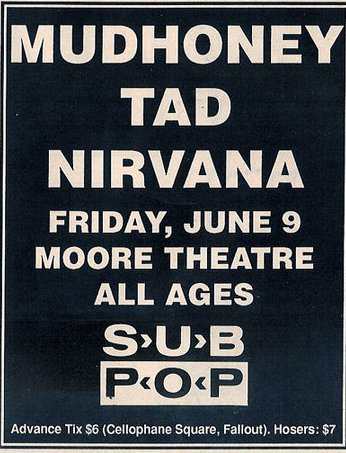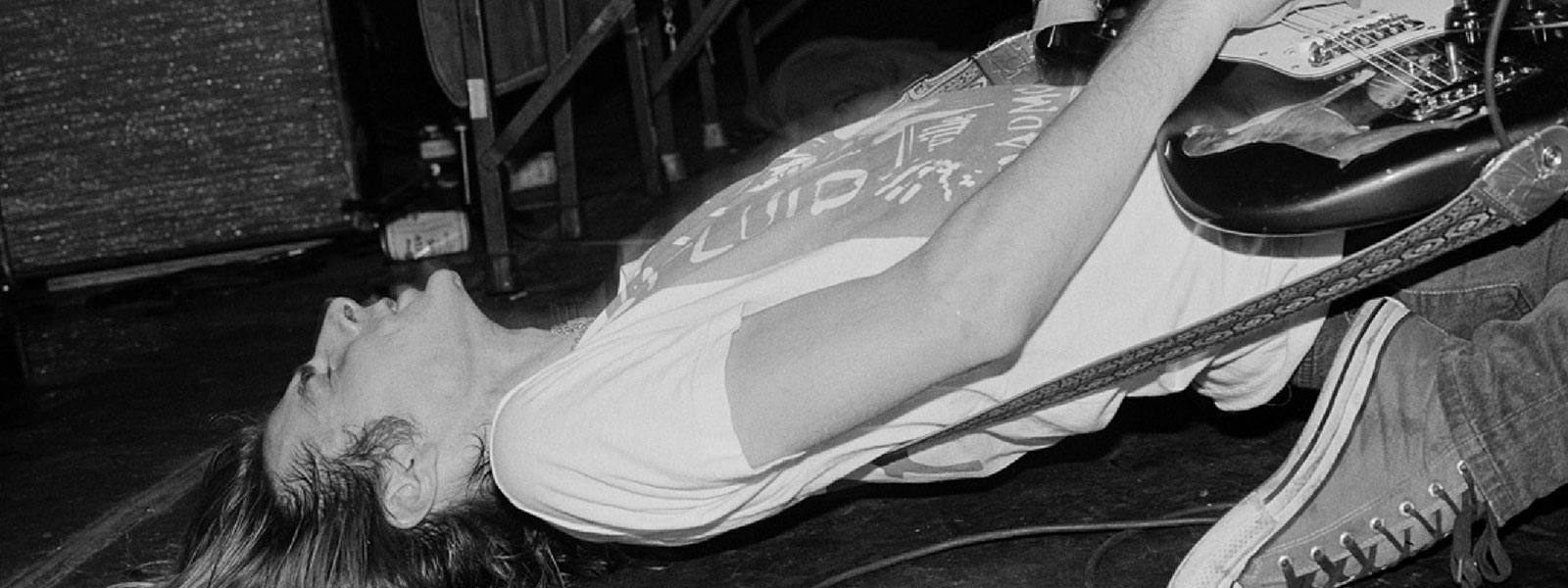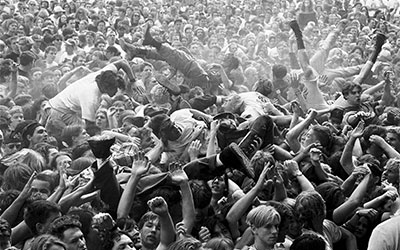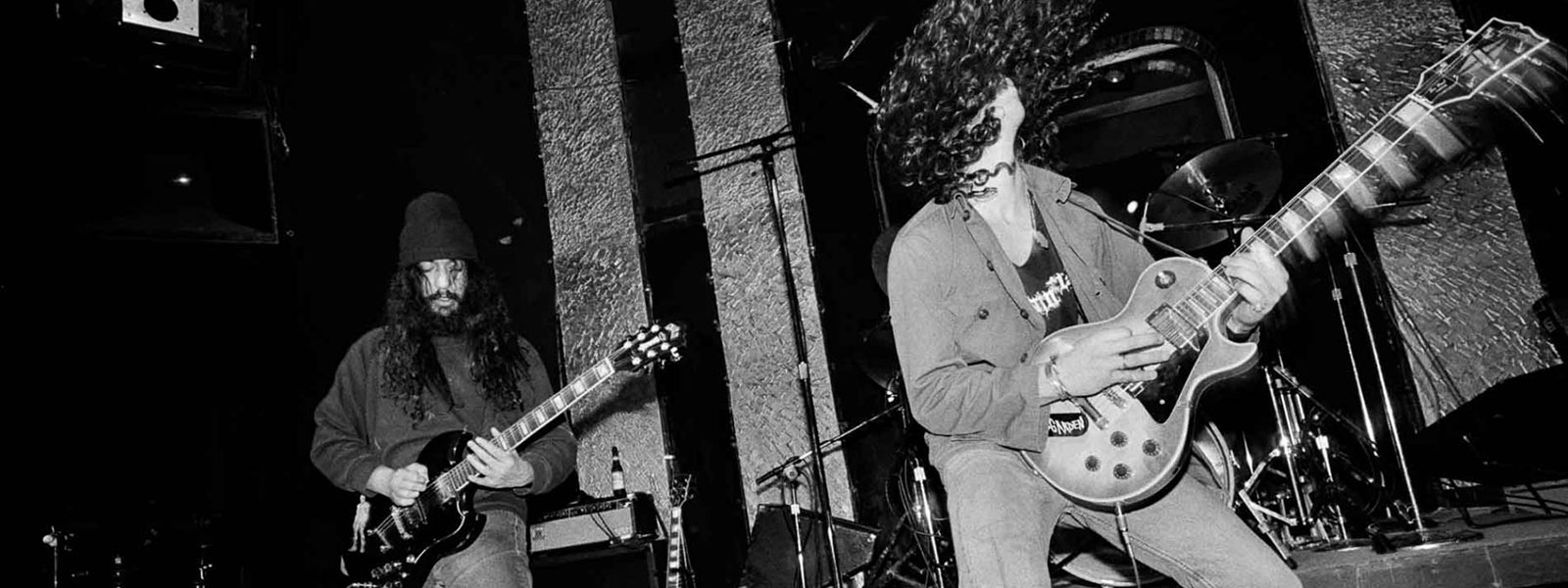Sub Pop Rock City: the story of the first Sub Pop Lame Fest
On June 9, 1989, Sub Pop hosted a showcase at the 1,400-capacity Moore Theatre with three acts from their “grunge” stable – Nirvana, Tad and Mudhoney. The sold-out show would be the first time any of the bands had played to an audience that large. It wouldn’t be the last
Seattle, 1989. The Sub Pop grunge hype machine was well underway and bands like Nirvana, Mudhoney, Soundgarden and TAD were getting traction in the Seattle much scene. The only thing missing was the crowds.
At that time, neither Sub Pop nor its bands were household names. Even in their own hometown, Nirvana, Mudhoney, TAD and the others were accustomed to playing to tiny crowds at venues like Seattle’s Central Tavern and The Vogue. Playing at a larger venue, like the Moore Theatre, was not even a thought for these bands. The historic Moore Theatre, with its 1,400-capacity and expansive stage? Not a chance.
But it was a real dream for Sub Pop, however, and they were determined to make it happen. Sub Pop co-founders Bruce Pavitt and Jonathan Poneman always had big plans and big dreams for his city and his label.
Sub Pop Lame Fest
- Nirvana, TAD, Mudhoney
- The Moore Theatre (Capacity: 1,400) 1932 2nd Ave
Seattle, Washington - 8 p.m.
- Tickets: $7 ($6 in advance)
- All Ages
Sub Pop Lame Fest had two purposes: to showcase the three jewels of Sub Pop’s roster, and act as the as a record release party for Nirvana’s debut album, Bleach. While Nirvana, Mudhoney, and TAD were “stars” of the underground club circuit, Pavitt and Poneman wanted more. They weren’t just thinking local. TAD’s Kurt Danielson told Northwest Passage that “Bruce and Jon both presented the idea of Lame Fest as a way to recognize that Sub Pop and Sub Pop bands had officially arrived on a local level but also relative to the national and international marketplace.”1

Sub Pop Lame Fest poster
But despite Sub Pop’s lofty aspirations, there was always some doubt the show could be a success. TAD vocalist and guitarist Tad Doyle: “Bruce and Jon were visionaries and took a huge chance on Lame Fest. I recall that Bruce was a little freaked out and worried that nobody was going to show up.”2
Mark Arm was also skeptical about the gig. “I remember thinking John and Bruce were crazy for booking the Moore. Because local bands never played the Moore. It was too big.”3 According to Pavitt, this skepticism was shared by the Moore management, who hired less security guards than normal for the gig. Low expectations were abound.
But like so many other times, the music spoke for itself.
The Show
To the surprise of everyone – except maybe Sub Pop – the show was a sell-out. The Moore was an all-ages venue, so it’s likely a lot of younger fans got to see these future grunge titans for the first time. The crowd was wild, energetic and perhaps a little too reckless, as we’ll discuss later.
“It was like, ‘Wow, who are these people, and where were they a year ago?’” according to Mudhoney’s Steve Turner. 4
Nirvana opened the show, and reports say that despite poor sound, the band played a “totally intense” show, according to a review in the local Backlash zine: “Hair explosions, prat falls, jumps, body writing and a trash-a-thon- finale that left instruments and bodies strewn about the stage.” At one point, Kurt Cobain jumped into the drum kit and got his hair tangled around his guitar strings. Despite this, he continued playing, even swinging his guitar as he walked around the stage.5
TAD was next on the bill. Not much has been documented about their performance, though Doyle recalls that their set was “pretty good that night.” It was the first time the band had played on a stage that large. He tells Northwest Passage that the Lame Fest show “was really fun. We were finally able to spread out onstage and have some space to move as opposed to being cramped on in a small space with all of our gear. The type of music we played then sounds better in bigger spaces anyhow.” Kurt Danielson concurs: “at first I was intimidated by the relatively big stage, something I hadn’t had experience with yet at that point. Initially it seemed a challenge to fill such a big space.”
Mudhoney headlined the show and played last, introduced by Ed Fotheringham. It was during Mudhoney’s set when tussles between the crowd and the bouncers really got out of control. Kurt Danielson remembers Mudhoney’s set with delight. “It was a transcendent experience. I was standing to the side of the stage with several others when Kurt [Cobain], who was standing next to me, remarked how he liked to pogo to Mudhoney and how he wondered why more people didn’t pogo anymore.”6 Cobain started pogoing and soon many people in the crowd joined him. According to Danielson, Mudhoney translated that energy into a great set.
The band had to stop three times during their set; at one point Mark Arm kicked a security guard in the back. He later recounted the problems with security in a 1990 interview with Maximumrocknroll:
It would have been a great show except that the security they hired was totally fucked. And they were – the kids were trying to hop on stage and jump off and they were just trying to – it was a fight between the security and the kids. And then we got involved because we were just getting sick of it and it would have been a great show had these assholes not been working. There was no need for security. There was absolutely no need.7
Doyle backs up Arm’s account. “Some of the security were a little heavy-handed with the audience,” he says. “We were ready to back Mark up if needed.”8
Reaction
Some critics were not impressed. Paul deBarros, writing for the Seattle Times, had this to say about Lame Fest:
The whole point of this show seems to be based on the perverse, reverse idea that grungy, foul-mouthed, self-despising meatheads who grind out undifferentiated noise and awing around their long hair are good—and ‘honest’—by virtue of their not being ‘rock stars.’ How confounded this primitivism is, which defines bands in the reverse image of someone else’s market position, instead of music… If this is the future of rock n’ roll, I hope I die before I get much older.9

Ticket stub to Sub Pop Lame Fest
But despite the crowd trouble and the negative media, Bruce Pavitt saw this as a watershed moment for Seattle and Sub Pop. “It was the turning point in the scene,” Pavitt said.10 “The whole place was shaking. Next day, word hit the street that the Moore had actually sold out a show of local bands. Then the local media really started talking the music a lot more seriously.”
The impact of Sub Pop Lame Fest, and the fact that for the first time a band with three local bands were able to sell out a venue as large as the Moore – wasn’t realized immediately. But the show’s success encouraged the Sub Pop brain trust to generate interest in the bands outside of Seattle. Starting in October 1989, Nirvana and TAD crisscrossed Europe together for what was referred to as the “Heavier than Heaven” tour. A month later, Mudhoney, embarked on their own tour that started in the UK and continued through seven other countries.
All three bands would later share a stage again at the Astoria Theatre in London on December 3, 1989, in what became known as Sub Pop Lame Fest UK. That show would further cement Sub Pop and the three bands into the UK underground music community. Back at home, the three bands would start playing to larger crowds in larger venues. The days of playing gigs in front of 30 people were over for good.
Of course, all three bands would end up leaving Sub Pop within a few years, albeit with varying degrees of success. Sub Pop’s first Lame Fest was the first chance to see all three bands together before a big crowd – as equals. The show changed how the local media perceived the local music scene. It also gave the bands an idea of what they were capable of.
“Prior to [Lame Fest], bands like TAD, Mudhoney and Nirvana would have been relegated to playing house and basement shows,” says Tad Doyle.
The impact of the first Sub Pop Lame Fest isn’t lost on Bruce Pavitt, either.
“That show ignited the city’s youth and put Seattle on the map.”11
Footnotes
- Northwest Passage email interview with Kurt Danielson, 6/30/2016.
- Northwest Passage email interview with Tad Doyle, 6/28/2016.
- Cameron, Keith. Mudhoney: The Sound and the Fury from Seattle. p. 118
- Yarm, Mark. Everybody Loves Our Town: An Oral History of Grunge, p. 199
- McMurray, Jacob. Taking Punk to the Masses, p. 147
- Northwest Passage email interview with Kurt Danielson, 6/30/2016.
- LaVella, Mike. Mudhoney interview. Maximumrocknroll, August 1990.
- Northwest Passage email interview with Tad Doyle, 6/30/2016.
- Email exchange with Jack Endino by author (Jessica Letkemann), 2004
- Cameron, Keith. Mudhoney: The Sound and the Fury from Seattle.
- Yarm, Mark. Everybody Loves Our Town: An Oral History of Grunge, p. 200


